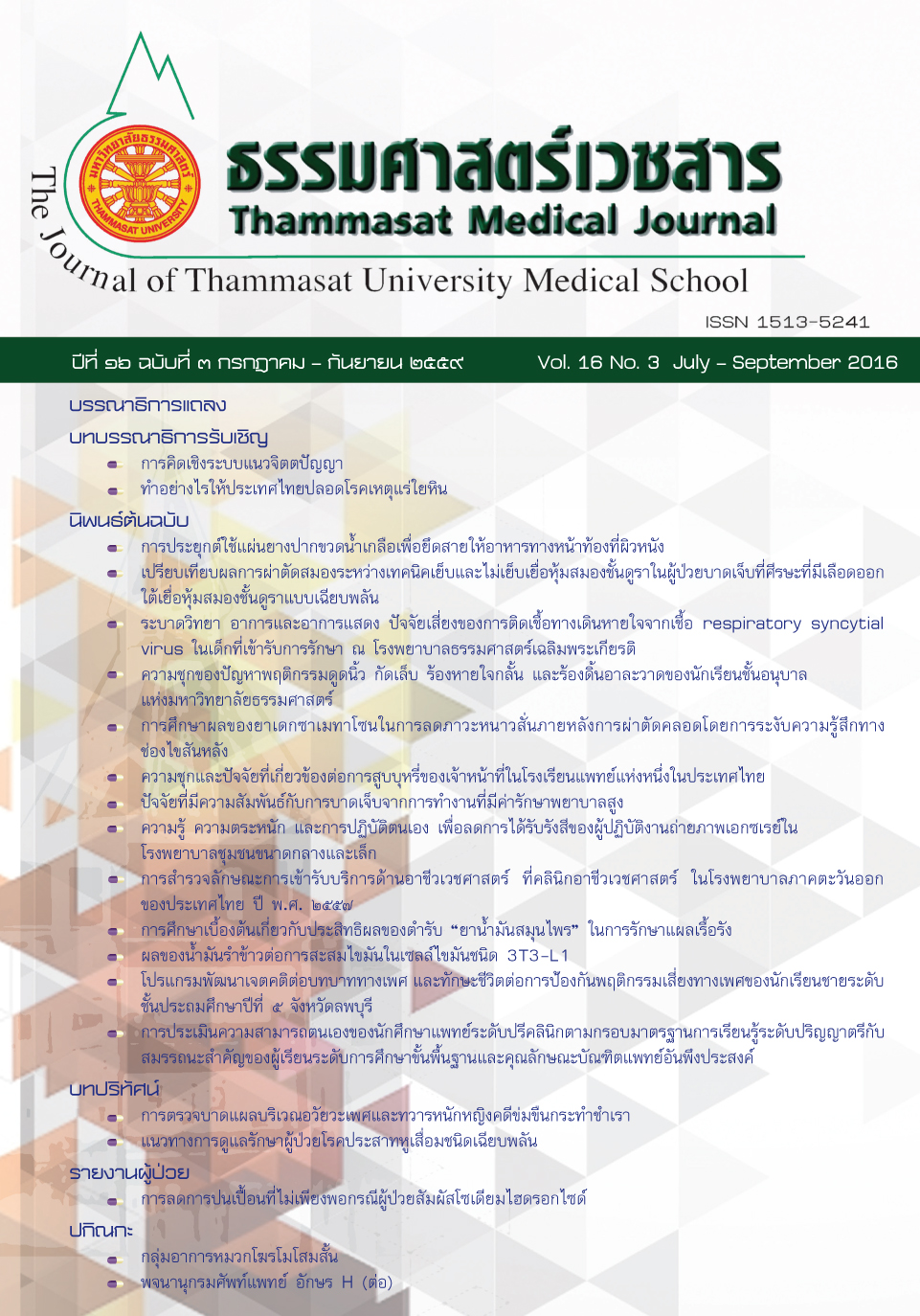Comparison outcome following watertight and non watertight duraplasty decompressive craniectomy in acute subdural hematoma
Keywords:
Decompressive craniectomy, Watertight duraplasty, Non watertight duraplasty, Subdural hematoma, การผ่าตัดแบบเย็บปิดเยื่อหุ้มสมองชั้นดูรา, การผ่าตัดแบบไม่เย็บปิดเยื่อหุ้มสมองชั้นดูราบาดเจ็บที่ศีรษะ, เลือดออกใต้เยื่อหุ้มสมองชั้นดูราAbstract
Introduction: The objective of this study was to compare outcome following decompressive craniectomy with watertight duraplasty technique and non watertight duraplasty technique in acute subdural hematoma.
Method: This was retrospective study, conducted from January 2008 until December 2014 in Chumphon Khet Udomsakdi hospital. The patients were divided into two groups: decompressive craniectomy with watertight duraplasty technique and decompressive craniectomy with non watertight duraplasty technique. Baseline characteristic, surgical outcome, complications, surgical time and length of hospital stay were recorded and analyzed with student t-test and Fisher’s exact test.
Result: Of the 207 patients, 116 patients who underwent decompressive craniectomy with watertight duraplasty technique and 91 patients who underwent decompressive craniectomy with non watertight duraplasty technique. Baseline patients characteristic were not significantly different between two groups. There were not significantly different between two groups in surgical outcome, CNS infection, surgical site infection, seizure and length of hospital stay (p = 0.819, 0.999, 0.999, 0.999, 0.384). In non watertight duraplasty technique group had higher CSF leakage rate than watertight duraplasty group with statistically significance (p = 0.001) but had lower surgical time than watertight duraplasty group with statistically significance (p < 0.001). There was no difference in length of hospital stay (p = 0.384).
Discussion and Conclusion: Decompressive craniectomy with watertight and non watertight duraplasty technique were effective procedure. There were not significantly different in surgical outcome and serious complications, but non watertight duraplasty technique had lower surgical time.
บทนำ:วัตถุประสงค์เพื่อเปรียบเทียบผลการผ่าตัดโรค acute subdural hematoma ระหว่างวิธีผ่าตัด แบบเย็บปิดเยื่อหุ้มสมองชั้นดูราและแบบไม่เย็บปิดเยื่อหุ้มสมองชั้นดูรา
วิธีการศึกษา: การศึกษาเชิงวิเคราะห์แบบย้อนหลังโดยทบทวนเวชระเบียนผู้ป่วยที่เข้ารับการผ่าตัดที่โรงพยาบาลชุมพรเขตรอุดมศักดิ์ ระหว่างเดือนมกราคม พ.ศ. ๒๕๕๑ ถึงเดือนธันวาคม พ.ศ. ๒๕๕๗ โดยกลุ่มที่หนึ่งผ่าตัดแบบเย็บปิดเยื่อหุ้มสมองชั้นดูรา และกลุ่มที่สองผ่าตัดแบบไม่เย็บปิดเยื่อหุ้มสมองชั้นดูราวิเคราะห์ข้อมูลเปรียบเทียบเรื่อง ผลการรักษาผลแทรกซ้อน เวลาที่ใช้ในการผ่าตัด และจำนวนวันนอนโรงพยาบาล โดยใช้สถิติ t-test และ Fisher’s exact test
ผลการศึกษา: ประชากรจำนวน ๒๐๗ ราย กลุ่มผ่าตัดแบบเย็บปิดเยื่อหุ้มสมองชั้นดูราจำนวน ๑๑๖ ราย และกลุ่มไม่เย็บปิดเยื่อหุ้มสมองชั้นดูรา จำนวน ๙๑ ราย การศึกษาพบว่าไม่แตกต่างกันในเรื่อง ผลการผ่าตัด การติดเชื้อในระบบประสาท การติดเชื้อที่แผลผ่าตัด การชัก และระยะเวลานอนโรงพยาบาล (p value = ๐.๘๑๙, ๐.๙๙๙, ๐.๙๙๙, ๐.๙๙๙ และ ๐.๓๘๔ ตามลำดับ) กลุ่มที่ไม่เย็บปิดเยื่อหุ้มสมองชั้นดูราใช้เวลาในการผ่าตัดน้อยกว่า (p < ๐.๐๐๑) แต่มีการรั่วของน้ำหล่อเลี้ยงสมองมากกว่า (p = ๐.๐๐๑) จำนวนวันนอนโรงพยาบาลไม่ต่างกัน (p = ๐.๓๘๔)
วิจารณ์ และสรุปผลการศึกษา: การผ่าตัดแบบเย็บปิดเยื่อหุ้มสมองชั้นดูราและแบบไม่เย็บปิดเยื่อหุ้มสมองชั้นดูรานั้นให้ผลการรักษา ผลแทรกซ้อนที่รุนแรงและอัตราการตายที่ไม่แตกต่างกัน แต่การผ่าตัดแบบไม่เย็บปิดเยื่อหุ้มสมองชั้นดูราใช้เวลาในการผ่าตัดน้อยกว่า



